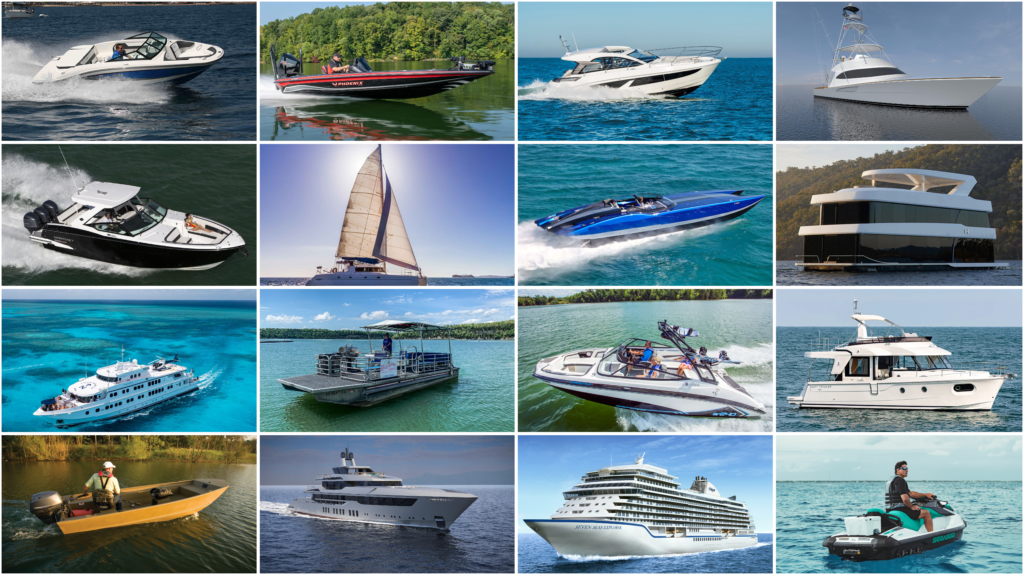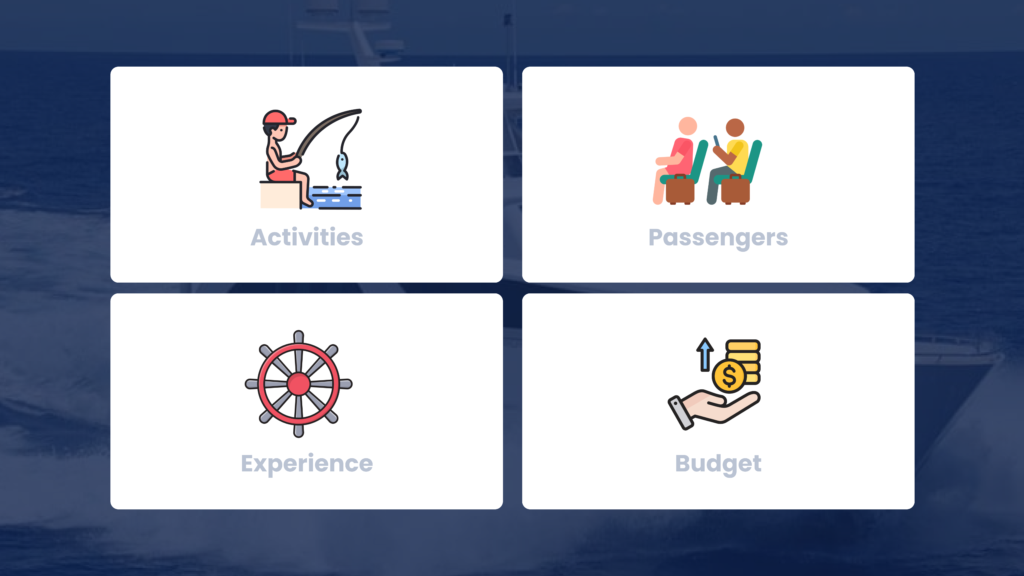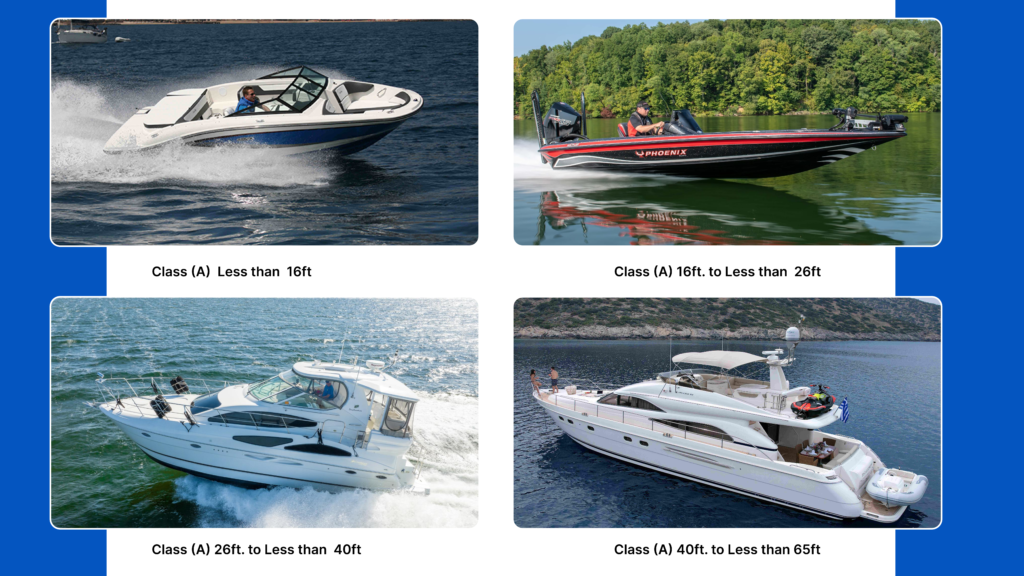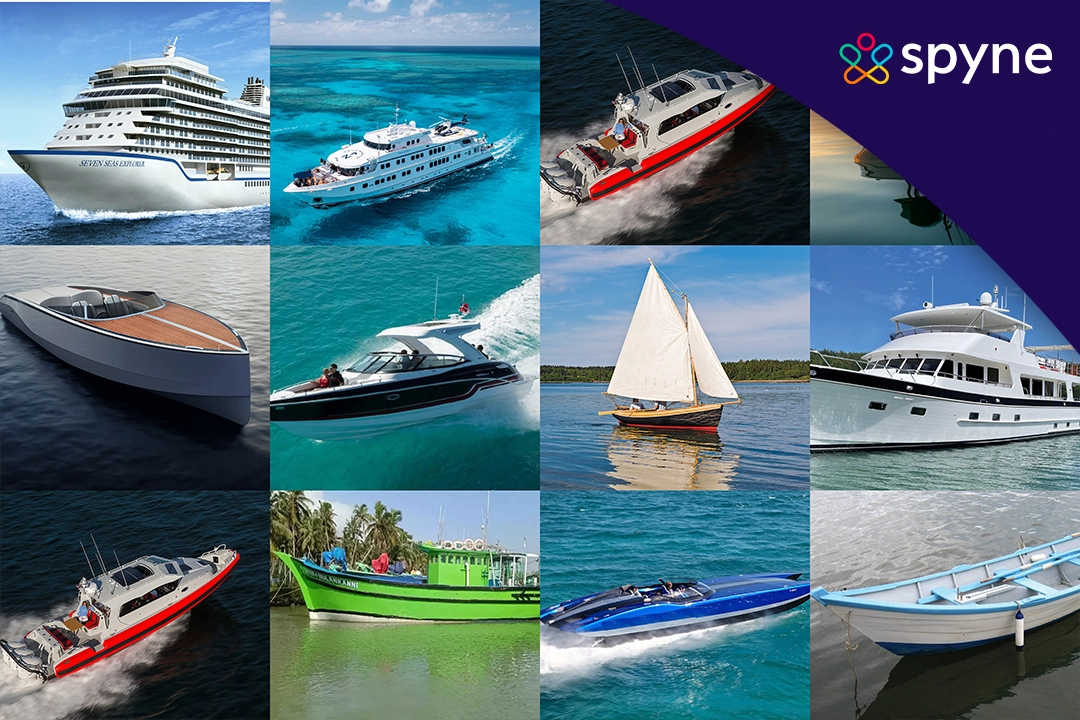Boats come in all shapes and sizes, each with its purpose. They sail across oceans, offering different experiences, like calm fishing trips or fancy yachting. From small dinghies to big superyachts, every boat has a job, like cruising, fishing, or doing watersports. Picking the right boat means thinking about what you want to do, like a boat photoshoot, fishing, and many other activities and your budget. This blog talks about different types of boats, their features, categories, and more.
Whether you’re up for excitement or just chilling on the water, understanding these boats makes your journey easy and fun.
What are The Different Types of Boats?
A boat has diverse types and sizes and is smaller than a ship. It stands out for being smaller, having a specific shape, and having the capacity to carry smaller boats. There are different kinds of boats and ships each known for its features and capabilities. Find the table below of different types of boats with pictures. Here we have listed 24 kinds of boats with their pros and cons:
| Boat | About | Pros | Cons |
| Pontoon | A pontoon boat is a flattish boat that relies on floats to remain floatable | Comfortable seating, good space, stays dry while you cruise, smooth ride & easy cleanup | Intense watersports, trailering down the road, Engine Choices |
| Cabin cruisers | A cabin cruise boat is just like a mobile mini home for vacation | Sheltered, overnight accommodations, amenities. | Higher cost, maintenance, and fuel consumption. |
| Fishing boats | A fishing boat is used to catch fish or other valuable aquatic animals. | Efficient for fishing, good stability. | May not be as comfortable for cruising or relaxation |
| Jetboats | A jetboat is a boat propelled by a jet of water ejected from the back of the craft. | Thrilling performance is maneuverable and is great for watersports. | Expensive, has high fuel consumption, and has loud engine noise |
| Jon boats | A jetboat is a boat propelled by a jet of water ejected from the back of the craft. | Affordable, lightweight, and easy to transport and store. | Limited capacity, rough handling in waves. |
| Sailboat | It is a boat propelled partly or entirely by sails and is smaller than a sailing ship. | Romantic, peaceful experience, low operating cost | Learning curve to sail, weather-dependent, limited storage space |
| Bass boats | It is a small boat that is specifically designed and equipped for bass fishing. | Optimized for bass fishing, good stability, and performance. | Less versatile for other activities, often expensive |
| Cuddy Boat | It typically does not have enough headroom but it may include a birth and toilet | Compact, affordable option for overnight trips. | Limited cabin space, may not be suitable for rough weather |
| Trawlers | A fishing trawler is a commercial fishing vessel designed to operate fishing trawls. | Comfortable living space, range, and fuel efficiency. | High initial cost, slow speed, requires experienced captain. |
| Bowriders | It is a kind of runabout boat with an offset helm and extra forward seating. | Fun for groups, versatile for activities, and good for watersports. | Rough-water handling can be challenging, with limited cabin space. |
| Houseboat | It is a type of boat that is designed or modified for dwelling. | Luxurious living space, unique experience | High cost, limited mobility, and mooring challenges. |
| Powerboat | It is a types of boat motors or speed boat that is powered by an engine. | Speed, performance, variety of options. | Fuel consumption, and maintenance, can be expensive. |

| Boat | Description | Pros | Cons |
| Jet ski | It is a personal watercraft also called a water scooter. | Thrilling, individual riding experience. | High cost, limited capacity, safety concerns |
| Motor yachts | It is a luxury motorboat that is engine-powered rather than by sail. | Ultimate comfort and amenities, long-range cruising. | Extremely expensive, high maintenance, and requires a crew. |
| Wakeboard | It is a watercraft in which the rider, stands on a wakeboard | Great for wakeboarding and towed watersports | Expensive, specialized use, and rough handling for other activities. |
| Bowrider boats | A bowrider or bowrider is a type of boat that has a seating area in the bow, the forward part of the ship. | Spacious & versatile, day cruising and easy to trailer | Lack of Overnight Accommodations, Limited Storage Space & Safety Concerns |
| Catamaran | A catamaran is a watercraft with two parallel types of boat hulls of equal size | Stable, spacious, comfortable | Higher cost, draft, and windage can be an issue |
| Dinghy | Dinghy is a huge variety of small boats. | Portable, easy to store and transport, affordable | Limited capacity, vulnerable to punctures |
| Aluminum fishing boats | Aluminum fishing boats come in three basic styles: Jon boats, Mod-V (or Modified-Vee), and Deep-V | Affordable, easy to maintain, good rough-water handling | Hot in the sun, limited storage space, can be noisy |
| Banana boats | Inflatable, towable boat for fun and thrills. | Exciting experience for groups, easy to transport and store | Limited capacity, vulnerable to punctures, not for serious boating. |
| Canoe | Paddle-powered boat for leisurely paddling on lakes and rivers | Quiet, peaceful experience, good for exercise and nature exploration | Requires skill and effort to paddle, limited capacity |
| High-performance boats | Designed for speed and adrenaline-pumping racing | Exhilarating, cutting-edge technology. | Expensive, high maintenance, safety concerns |
| Mackinaw boats | Powerful boats for open water and fishing in harsh conditions. | Strong, capable in rough seas, spacious. | Expensive, high fuel consumption, requires experience |
| Runabouts | Small, open boat for fun and cruising on calm waters | Affordable, easy to handle, good for groups | Limited rough-water handling, less storage space |
Overall, we have listed here various types of boats and ships including small different boat types and large yachts, find the perfect one that fits your preferences.
What’s the Difference Between a Ship and a Boat?
The primary difference between a ship and a boat is that a boat is used to refer to any small or mid-size watergoing vessel that is usually used for traveling purposes through waterways. Ships are large ocean-faring very large water vessels that usually travel through seas and oceans. These large vessels are known as ships and use multiple types of boat engines.
What are the Best Types of Boats for Lakes?
There are many types of boats specifically for lakes. Below are the lists of types of boats top 6 best types of boats for lakes:
1) Pontoon Boats
Pontoon boats are highly popular for lake boating, it offers a variety of performances, sizes, and amenities. It is an excellent fishing platform and also good for slow cruising, modern pontoon boats offer impressive speed at 40 MPH or faster.
2) Bowriders: Open-bow cockpits with added passenger seating spaces define these boats. People use classic lake boats for cruising around the lake, participating in various water sports, and even fishing.
3) Watersports Boats: These boats are designed specifically for board sports by including ballast and other equipment that produce ginormous wakes. They also come with vast spaces accommodating enough people.
4) Fishing Boats: This category includes bass boats, fish-n-skis, and center consoles which have been fabricated looking at the needs of anglers but are also meant to serve families.
5) Personal Watercraft (PWC): These PWCs have nimble hulls, and strong engines and are relatively close to water at all times. In addition to this, they remain among the most enjoyable rides ever invented on earth today and can do more than one rainfall season.
6) Deck Boats: Runabout’s overall size range goes from less than 16 feet (4.88 м) to above 27 feet (8.23 м), and they usually consist of fiberglass material but some even use aluminum, they mostly come with outboard motors while others may have stern drives too.
What are the Special Boats for Shallow Water and Big Wakes?
A specific class of boats is designed for shallow and big water lakes. These specific boats include airboats, flatboats, and johnboats with gator tail mud motors. These vessels excel in accessing inaccessible backwaters, ideal for anglers pursuing prized catches in marshlands, swamps, rivers, and lakes. Therefore, wake boats are crafted to generate impressive wakes for surfing. Achieving this involves filling their hulls with water to increase weight, powered by robust engines that propel them through the water. The outcome is the ability to create surf-worthy waves at will, catering to enthusiasts seeking thrilling water sports experiences.
How To Choose The Right Types of Boat?
Choosing the right type of boat is hard when you aren’t sure about the options in the market it can feel overwhelming with so many options! No worries! Here’s a guide to help you navigate the seas of decision-making:
Start with your why you want a boat:
1) Activities: What do you want to do with your boat? Fishing, boat photography, cruising, watersports, diving, or living aboard? Different activities require different features so it is essential to understand what activities you are planning to do with your boat.
2) Passengers: How many people will you usually be boating with? Consider comfort and capacity. This is the important factor that you must consider while choosing the right boat for you.

3) Experience: Are you a seasoned sailor or a first-time skipper? Some boats are easier to handle than others.
4) Budget: Set a realistic purchase, maintenance, and storage budget. Owning a boat is an investment! Stay within the budget and avoid overspending.
Look for details:
1) Size: Bigger isn’t always better. Consider, storage space, and also ease of handling.
2) Hull material: Fiberglass, aluminum, wood, and inflatables have pros and cons regarding durability, maintenance, and performance.
3) Engine (powerboats): Outboard, inboard, or sterndrive engines affect performance, handling, and maintenance needs.
4) Features: Think about desired amenities like cabins, bathrooms, sun decks, fishing equipment, or water sports accessories.
Once you are sure about priorities, look for the different types of boats and choose the right one for you according to your preferences and budget.
What are the Four Classes of Boats?
Boat categorization helps the government authorities (state & federal) to determine the use of a specific boat. The classification of ships can decide how many people can travel in it, including the number of passengers, flotation devices, and also essential equipment. Below are the four classes of boats:
Boat Class Breakdown
- Class A: Compact crafts under 16 feet in length.
- Class 1: Medium-sized vessels ranging from 16 to less than 26 feet.
- Class 2: Larger boats measuring 26 to less than 40 feet.
- Class 3: Substantial watercraft between 40 and 65 feet in length.
- SRV (Small Research Vessel): Specialized boats exceeding 65 feet but under 300 gross tons, primarily used for research purposes.

By assigning a class to each boat, regulatory bodies can establish appropriate safety standards and restrictions, safeguarding passengers and the marine environment.
What are The Four Categories of Boats?
The European Union set rules in 1998 to categorize boats built and sold there. These rules help determine how well a boat can handle different wave heights and wind conditions. Additionally, they apply to most boats that are 8 to 79 feet long.
Below we have categorized boats into 4 categories:
Category A – Ocean Class Boats
These boats are self-sufficient and designed for long trips in very rough conditions, including winds over 40 knots (Force 8 on the Beaufort scale) and waves over 13 feet high. People do not intend them for hurricanes or typhoons.
Category B – Offshore Class Boats
Boats in this class can handle offshore conditions with winds up to 40 knots and waves up to 13 feet high.
Category C – Inshore Class Boats
These boats are suitable for lakes, rivers, coastlines, and large bays. They can handle winds up to 27 knots (Force 6) and waves up to seven feet high.
Category D – Coastal Water, Inland, and Sheltered Waters
People design boats in this category for rivers and small lakes, able to withstand winds between 11 and 16 knots (Force 4) and waves up to 18 inches high.
Although not all boat builders in the United States adhere to these standards, rental services like Boatsetter, especially in Europe, offer many boats that meet these requirements. These standards also apply to boats built in the U.S. by European manufacturers. Knowing a boat’s category helps owners understand its seaworthiness before planning trips, such as to the Caribbean.
Uses of Different Types of Boats
When it comes to boating or buying a boat choosing from different types of boats for endless water activities, discover which boat type fits best for your needs and you must understand the uses of specific boats.
Below you will types of boats list uses for different types of boats:
| Types of Boats | Uses |
| Small Boats | Recreational activities
Water sports Fishing Boating business Short travels Military service Combat use Liveaboard lifestyle |
| Medium Boats | Cruising
Fishing Watersports |
| Large Boats | Long travels
Goods and cargo transportation Cruise vacations. Shipping industry |
Conclusion
There are multiple types of boat photography that you need to explore when searching for the right boat for you. If you’re a fan of fishing or prefer laid-back cruises, understanding your preferences will make the decision easy. So, as you put on your life jacket, establish a reasonable budget, and explore boat options with confidence. Picture delightful moments on the water – imagine calm waters, sunny skies, and joy-filled sailing adventures. As you take the helm of boat ownership, may each voyage bring you waves of happiness and smooth sailing.















